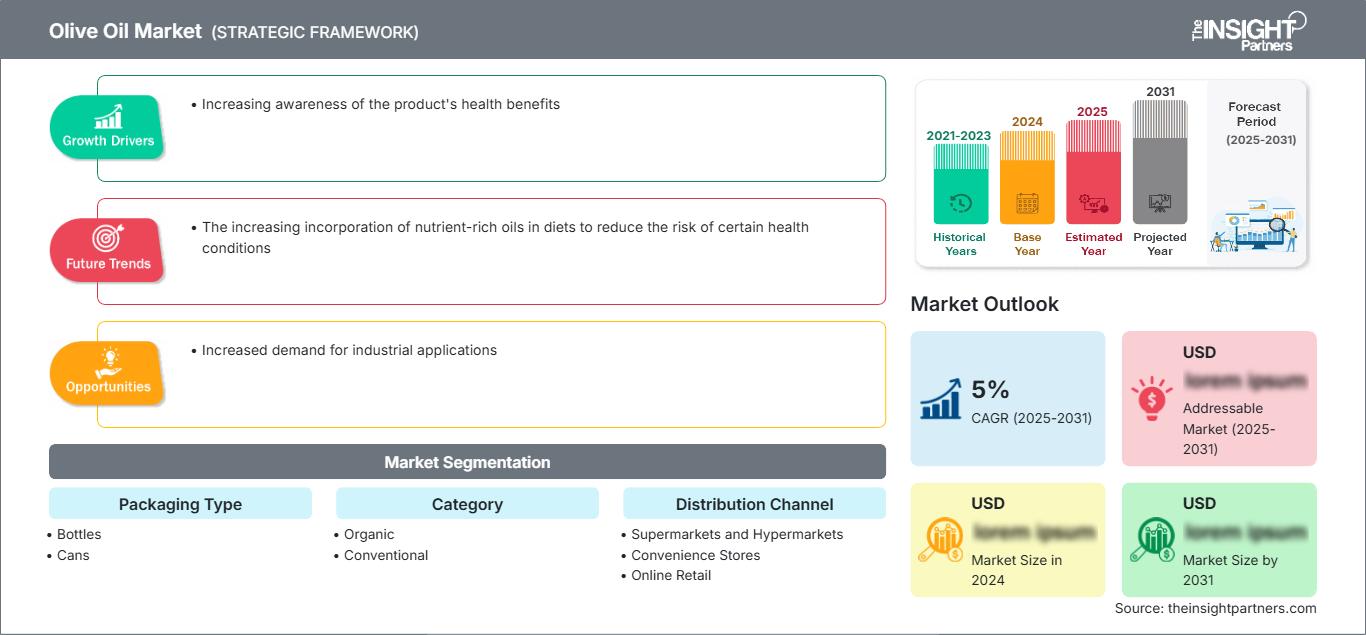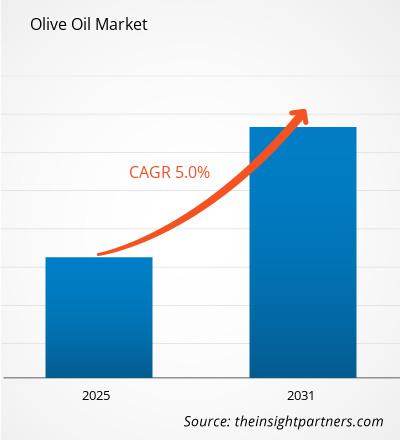Se espera que el mercado del aceite de oliva registre una tasa de crecimiento anual compuesta (TCAC) del 5 % entre 2023 y 2031. Es probable que la creciente incorporación de aceites ricos en nutrientes en las dietas para reducir el riesgo de ciertas afecciones siga siendo una tendencia clave en el mercado.
Análisis del mercado del aceite de oliva:
- El mercado está experimentando un fuerte crecimiento debido principalmente a la creciente demanda de aceite de oliva en el sector de servicios de alimentación y en el minorista.
- Además, también se prevé que la demanda de cocinas exóticas impulse la popularidad del aceite de fruta europea Olea en varias partes del mundo.
- El aceite de olea europea es esencial en la dieta mediterránea debido a sus numerosos beneficios para la salud. Se prevé que la concienciación sobre estos beneficios, atribuidos a su contenido en ácidos grasos omega-3, impulse su demanda en los próximos años.
- La demanda de este aceite también está aumentando debido a su utilización como ingrediente en la fabricación de suplementos dietéticos y productos farmacéuticos.
Panorama del mercado del aceite de oliva
- El aceite de oliva se obtiene de la aceituna y está disponible como aceite de oliva virgen, aceite de oliva virgen extra, aceite de oliva ligero, aceite de orujo de oliva y aceite de oliva refinado.
- El aceite de oliva virgen extra se utiliza en alimentación, cuidado corporal y otros productos. Es un líquido multiusos, por lo que lo consume la mayoría de la población mundial.
- Este aceite se utiliza para cocinar, hornear y aliñar ensaladas. Además, el aceite de oliva virgen extra es rico en antioxidantes y grasas monoinsaturadas, lo que le confiere un sabor suave.
- Las personas preocupadas por su salud prefieren cocinar con aceite de oliva por sus beneficios. El aceite de oliva virgen extra es saludable para el corazón y ayuda a controlar la obesidad.
- El mercado del aceite de oliva virgen extra juega un papel importante en el cuidado de la piel, ya que este aceite hidrata y cura la piel.
Personalice este informe según sus necesidades
Obtendrá personalización en cualquier informe, sin cargo, incluidas partes de este informe o análisis a nivel de país, paquete de datos de Excel, así como también grandes ofertas y descuentos para empresas emergentes y universidades.
Mercado del aceite de oliva: Perspectivas estratégicas

- Obtenga las principales tendencias clave del mercado de este informe.Esta muestra GRATUITA incluirá análisis de datos, desde tendencias del mercado hasta estimaciones y pronósticos.
Impulsores y oportunidades del mercado del aceite de oliva
Aumentar la conciencia sobre los beneficios del producto para la salud
- La creciente conciencia de los consumidores sobre los beneficios del aceite de oliva para la salud se ha convertido en un importante impulsor del mercado.
- A medida que los consumidores se vuelven más conscientes de la salud y buscan alternativas saludables, la demanda de aceite de oliva se ha disparado, ya que se sabe que es rico en grasas monoinsaturadas y antioxidantes y tiene propiedades antiinflamatorias, que a su vez están directamente relacionadas con la reducción de riesgos de enfermedades cardíacas y otras enfermedades graves como el accidente cerebrovascular y ciertos tipos de cáncer, así como el temido Alzheimer.
- Las investigaciones en este ámbito, hoy positivas y extendidas en el ámbito médico, han convertido al aceite de oliva en un superalimento en la mente de los consumidores.
- Estos beneficios y el efecto halo de la dieta mediterránea, ampliamente promocionada como saludable y que incluye el aceite de oliva como un alimento básico importante, han animado a fabricantes y comercializadores a destacar los beneficios del aceite de oliva para la salud en sus estrategias de marketing. Esto ha resultado en un aumento de la demanda y las ventas en todos los segmentos de consumidores.
Aumento de la demanda de aplicaciones industriales
- La creciente necesidad de usos industriales también supone una gran oportunidad para el mercado del aceite de oliva.
- A medida que los fabricantes y consumidores globales buscan alternativas naturales y más saludables a los ingredientes sintéticos, el aceite de oliva se utiliza cada vez más en diversas industrias.
- En cosmética se valora por sus propiedades hidratantes y antioxidantes, por lo que se utiliza en cremas y lociones para la piel y el cabello.
- En el sector farmacéutico, el aceite de oliva se utiliza para formular fármacos como vehículo y fabricar suplementos. En la industria, sus propiedades lubricantes lo convierten en una opción más respetuosa con el medio ambiente para algunos procesos.
- Esta diversificación de usos amplía el mercado para los productores de aceite de oliva, ayuda a estabilizar la demanda y aumenta potencialmente el margen de beneficio de los productores en los segmentos no alimentarios.
Análisis de segmentación del informe de mercado del aceite de oliva
El alcance del mercado mundial del aceite de oliva está segmentado según el tipo de envase, la categoría y el canal de distribución.
- Según el tipo de envase, el mercado del aceite de oliva se segmenta en botellas, latas y otros.
- Según la categoría, el mercado se bifurca en orgánico y convencional.
- Según el canal de distribución, el mercado se clasifica en supermercados e hipermercados, tiendas de conveniencia, venta minorista en línea y otros.
Análisis de la cuota de mercado del aceite de oliva por geografía
- El informe del mercado del aceite de oliva comprende un análisis detallado de cinco regiones geográficas principales, que incluye el tamaño actual e histórico del mercado y los pronósticos para 2021 a 2031, cubriendo América del Norte, Europa, Asia-Pacífico (APAC), Medio Oriente y África (MEA) y América del Sur y Central.
- Cada región se subdivide en sus respectivos países. Este informe proporciona análisis y pronósticos de más de 18 países, abarcando la dinámica del mercado del aceite de oliva, como los factores impulsores, las tendencias y las oportunidades que impactan los mercados a nivel regional.
- Además, el informe cubre el análisis de las Cinco Fuerzas de Porter, que implica el estudio de los principales factores que influyen en el mercado del aceite de oliva en estas regiones.
Perspectivas regionales del mercado del aceite de oliva
Los analistas de The Insight Partners han explicado detalladamente las tendencias regionales y los factores que influyen en el mercado del aceite de oliva durante el período de pronóstico. Esta sección también analiza los segmentos y la geografía del mercado del aceite de oliva en Norteamérica, Europa, Asia Pacífico, Oriente Medio y África, y Sudamérica y Centroamérica.
Alcance del informe del mercado del aceite de oliva
| Atributo del informe | Detalles |
|---|---|
| Tamaño del mercado en 2024 | US$ XX millones |
| Tamaño del mercado en 2031 | US$ XX millones |
| CAGR global (2025-2031) | 5% |
| Datos históricos | 2021-2023 |
| Período de pronóstico | 2025-2031 |
| Segmentos cubiertos | Por tipo de embalaje
|
| Regiones y países cubiertos | América del norte
|
| Líderes del mercado y perfiles de empresas clave |
|
Densidad de actores del mercado del aceite de oliva: comprensión de su impacto en la dinámica empresarial
El mercado del aceite de oliva está creciendo rápidamente, impulsado por la creciente demanda del consumidor final debido a factores como la evolución de las preferencias del consumidor, los avances tecnológicos y un mayor conocimiento de los beneficios del producto. A medida que aumenta la demanda, las empresas amplían su oferta, innovan para satisfacer las necesidades del consumidor y aprovechan las tendencias emergentes, lo que impulsa aún más el crecimiento del mercado.

- Obtenga una descripción general de los principales actores clave del mercado del aceite de oliva
Noticias y desarrollos recientes del mercado del aceite de oliva:
El mercado del aceite de oliva se evalúa mediante la recopilación de datos cualitativos y cuantitativos tras una investigación primaria y secundaria, que incluye importantes publicaciones corporativas, datos de asociaciones y bases de datos. A continuación, se presenta una lista de las novedades en el mercado en cuanto a innovación, expansión empresarial y estrategias:
- GOOD PLANeT Foods, conocida por su queso con aceite de oliva, amplió su línea de productos con queso en lonchas en sabores Cheddar Fuerte y Gouda Ahumado, ofreciendo opciones sin lácteos con un sabor excepcional, fácil de fundir y beneficios para la salud cardiovascular gracias al uso de aceite de oliva. (Fuente: GOOD PLANeT Foods, comunicado de prensa, marzo de 2024)
- Neolea, productor mediterráneo, presentó su aceite de oliva virgen extra en un envase sostenible de lata de aluminio, con un tapón reutilizable "Fresh Cap" para garantizar la integridad, la frescura y el sabor del aceite. (Fuente: Neolea, Boletín informativo, mayo de 2024)
Informe sobre el mercado del aceite de oliva: cobertura y resultados
El informe "Tamaño y pronóstico del mercado del aceite de oliva (2021-2031)" ofrece un análisis detallado del mercado que abarca las siguientes áreas:
- Tamaño del mercado del aceite de oliva y pronóstico a nivel mundial, regional y nacional para todos los segmentos clave del mercado cubiertos bajo el alcance
- Tendencias del mercado del aceite de oliva, así como dinámicas del mercado, como impulsores, restricciones y oportunidades clave.
- Análisis detallado PEST/de las cinco fuerzas de Porter y FODA
- Análisis del mercado del aceite de oliva que abarca las tendencias clave del mercado, el marco global y regional, los principales actores, las regulaciones y los desarrollos recientes del mercado.
- Análisis del panorama industrial y de la competencia que abarca la concentración del mercado, el análisis de mapas de calor, los actores principales y los desarrollos recientes del mercado del aceite de oliva.
- Perfiles detallados de empresas
- Análisis histórico (2 años), año base, pronóstico (7 años) con CAGR
- Análisis PEST y FODA
- Tamaño del mercado, valor/volumen: global, regional y nacional
- Industria y panorama competitivo
- Conjunto de datos de Excel
Informes recientes
Informes relacionados
Testimonios
Razón para comprar
- Toma de decisiones informada
- Comprensión de la dinámica del mercado
- Análisis competitivo
- Información sobre clientes
- Pronósticos del mercado
- Mitigación de riesgos
- Planificación estratégica
- Justificación de la inversión
- Identificación de mercados emergentes
- Mejora de las estrategias de marketing
- Impulso de la eficiencia operativa
- Alineación con las tendencias regulatorias




















 Obtenga una muestra gratuita para - Mercado del aceite de oliva
Obtenga una muestra gratuita para - Mercado del aceite de oliva